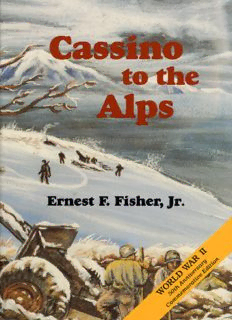
Cassino to the Alps PDF
Preview Cassino to the Alps
. . . t o Those Who Served Foreword From September 1943, when Allied troops came ashore near Salerno, until German surrender in May 1945, 312,000 Allied soldiers were killed, wounded, or missing in Italy. Was a campaign that from the first faced the bleak prospect of coming to a dead end against the forbidding escarpment oft he Alps wortht hat cost? Was the objective of tying down German troops to avoid their commitment in northwestern Europe all that the campaign might have accomplished? The answers to those questions have long been sought but, as is the nature of history, must forever remain conjecture. What is established fact, as this volume makes clear, is the tenacity and intrepidity displayed by American and Allied soldiers in the face of a determined and resourceful enemy, harsh weather, sharply convoluted terrain, limited numbers, and indefinite goals in what many of them must have looked upon as a backwater of the war. This volume relates the story of the last year of their struggle. Three volumes previously published tell of the campaign in northwest Africa, the conquest of Sicily and covert politico-military negotiations leading to surrender of the Italian armed forces, and the campaign from the Allied landings on the mainland through the bitter disappointment of the amphibious assault at Anzio. This volume is thus the capstone of a four- volume series dealing with American military operations in the western Mediterranean. Washington, D.C. JAMES L. COLLINS, JR. 1 April 1976 Brigadier General, USA Chief of Military History vii The Author Ernest F. Fisher, Jr., graduated from Boston University in 1941, and in World War II served in Europe with the 501st Parachute Infantry, 101st Airborne Division. He returned to Boston University and received an M.A. in 1947 and in 1952 a Ph.D. degree in history from the University of Wisconsin. From 1954 to 1959 Dr. Fisher was a historian with Headquarters, U.S. Army, Europe. Since 1960 he has been a member of the staff of the Center of Military History. He is a retired colonel in the Army of the United States. viii Preface “Wars should be fought,” an American corps commander noted in his diary during the campaign in Italy, “in better country than this.”1 It was indeed an incredibly difficult place to fight a war. The Italian peninsula is only some 150 miles wide, much of it dominated by some of the world’s most precipitous mountains. Nor was the weather much help. It seemed to those involved that it was always either unendurably hot or bone-chilling cold. Yet American troops fought with remarkable courage and tenacity, and in company with a veritable melange of Allied troops: Belgians, Brazilians, British, Canadians, Cypriots, French (including superb mountain troops from Algeria and Morocco), Palestinian Jews, Indians, Italians, Nepalese, New Zealanders, Poles, South Africans, Syro-Lebanese, and Yugoslavians. The combatants also included the United States Army’s only specialized mountain division, one of its last two segregated all-Negro divisions, and a regimental combat team composed of Americans of Japanese descent. Despite the forbidding terrain, Allied commanders several times turned it to their advantage achieving penetrations or breakthroughs over some of the most rugged mountains in the peninsula. To bypass mountainous terrain, the Allies at times resorted to amphibious landings, notably at Anzio. Thereafter German commanders forced to reckon with the possibility of other such operations, had to hold back forces to protect their long coastal flanks. The campaign involved one ponderous attack after another against fortified positions: the Winter Line, the Gustav Line, the Gothic Line. It called for ingenuity in employing tanks and tank destroyers over terrain that to the armored soldier seemed to be one vast antitank ditch. It took another kind of ingenuity in devising methods to get at the enemy in flooded lowlands along the Adriatic coast. It was also a campaign replete with controversy, as might have been expected in a theater where the presence of various nationalities and two fairly equal partners imposed considerable strain on the process of coalition command. Most troublesome of the questions that caused controversy were: Did the American commander, Mark Clark err in focusing on the capture of Rome rather. than conforming with the wishes of his British superior to try to trap retreating German forces? Did Allied 1 Martin Blumenson, Salerno to Cassino, UNITED STATES ARMY IN WORLD WAR II (Washington, 1969), p. 234, quoting Maj. Gen. John P. Lucas. ix
